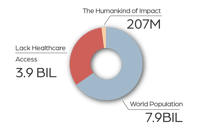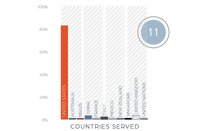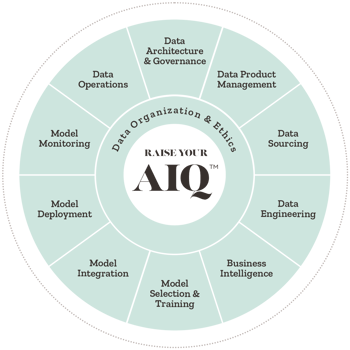Too Much Data, Too Little Time: A Business Case for Dimensionality Reduction
Introduction to Dimensionality Reduction
High-Dimensional Data
Imagine a spreadsheet with one hundred columns and...
for the health of people

for the health of planet

for the health of business

|
FOR THE HEALTH OF PEOPLE: EQUITY
|
 |
|
“The work [with Synaptiq] is unprecedented in its scale and potential impact,” Mortenson Center’s Managing Director Laura MacDonald MacDonald said. “It ties together our center’s strengths in impact evaluation and sensor deployment to generate evidence that informs development tools, policy, and practice.”
|
| Read the Case Study ⇢ |
|
DATA STRATEGY
|
 |
|
A startup in digital health trained a risk model to open up a robust, precise, and scalable processing pipeline so providers could move faster, and patients could move with confidence after spinal surgery.
|
| Read the Case Study ⇢ |
|
PREDICTIVE ANALYTICS
|
 |
|
Thwart errors, relieve in-take form exhaustion, and build a more accurate data picture for patients in chronic pain? Those who prefer the natural albeit comprehensive path to health and wellness said: sign me up.
|
| Read the Case Study ⇢ |
|
MACHINE VISION
|
 |
|
Using a dynamic machine vision solution for detecting plaques in the carotid artery and providing care teams with rapid answers, saves lives with early disease detection and monitoring.
|
| Read the Case Study ⇢ |
|
INTELLIGENT AUTOMATION
|
-1.jpg?width=296&height=196&name=man-wong-aSERflF331A-unsplash%20(1)-1.jpg) |
|
This global law firm needed to be fast, adaptive, and provide unrivaled client service under pressure, intelligent automation did just that plus it made time for what matters most: meaningful human interactions.
|
| Read the Case Study ⇢ |
 |
|
Mushrooms, Goats, and Machine Learning: What do they all have in common? You may never know unless you get started exploring the fundamentals of Machine Learning with Dr. Tim Oates, Synaptiq's Chief Data Scientist. You can read and visualize his new book in Python, tinker with inputs, and practice machine learning techniques for free. |
| Start Chapter 1 Now ⇢ |

By: Malika Amoruso 1 Oct 12, 2023 10:49:14 PM

Photo cred: @AviRichards on Unsplash
In the dynamic realm of technology, the advent of Artificial Intelligence (AI) in the workplace triggers a blend of excitement and uncertainty. At the heart of this complex interplay lies a fundamental question: can AI be a valuable asset in our professional lives, rather than a looming threat?
Let’s address the apprehensions head-on. Job displacement, skill shifts, and ethical concerns have long dominated discussions about AI’s integration into the workplace. However, it’s crucial to reframe our perspective and recognize AI as a powerful tool that can reshape the way we work.
The fear of job displacement is understandable, yet research paints a different picture. Reports from the World Economic Forum suggest that while AI might displace about 85 million jobs by 2025, it’s also forecasted to create 97 million new roles that are more aligned with the evolving collaboration between humans and algorithms [1]. AI’s rise demands distinctly human skills - creativity, empathy, and intricate problem-solving - skills that are irreplaceable.
Our jobs might transform, but they are far from vanishing; they are evolving.
Skill shifts are an integral part of this evolution. Continuous learning and upskilling are imperative, and AI can be our guiding light in this endeavor. Harvard School of Business indicates that tech-savvy professionals, working alongside automation, command higher wages, showcasing the synergistic relationship between humans and technology.
Another concern related to this upskilling is the barrier to learning posed by technology learning costs. Thankfully, outlets like Tech.co have started providing roundups of high-quality, free courses offered by technology giants like Microsoft, geared towards making AI skills accessible. Here at Synaptiq, we’re also passionate about making sure AI becomes accessible to all: our co-founder and Chief Data Scientist, Dr. Tim Oates is writing a free interactive guide on machine learning. Read the first chapter here:
Another common concern surrounding the hype around AI in the workplace is ethical usage [3]. Many open-source AI tools have been proven to pose issues of data privacy and algorithmic bias. Algorithmic bias is when AI models make decisions that are systematically skewed against different groups and types of people. The solution for these well-founded fears lies in embracing and mandating diverse training datasets, averting discrimination during model development, and actively championing data privacy compliance regulations.
Despite these very practical concerns, AI has a role to play in making the workplace not only more efficient, but arguably more human-centered, creative, and innovative. Read on to learn how.
Imagine a learning platform attuned to your unique learning patterns. AI-driven tools recommend specific courses, enabling continuous growth. From breaking down complex concepts into digestible parts to offering personalized study schedules, AI facilitates efficient learning, empowering you to acquire new skills effectively.
One example of this is Quizlet’s new AI-powered features. These features include Memory Scores, which track and schedule review time for users to efficiently absorb new material, Quick Summary which takes flash summaries from readings, and Brain Beats which turns flashcards created by users into catchy songs to help students learn more quickly. They’ve also integrated ChatGPT as a chat tutor to help students and adults seeking professional development that expands beyond basic concepts [8].
Sites like Training Industry have started to provide prompt engineering resources for individuals looking to upskill. These include ready-to-use prompts that anyone can use to ask tools like ChatGPT and Bard for free training information and support. Here are some examples:
“I want to learn [insert skill]. Generate a 60-day plan that will help a beginner like me learn the skill accordingly.”
“Can you provide a step-by-step guide or framework for approaching [insert topic], starting from the basics and progressing to advanced concepts?”
“Are there any industry certifications or qualifications I should consider pursuing to validate my skills in [insert field]?”
Envision a workplace where monotonous tasks are automated, allowing you to focus on stimulating work. AI-driven applications streamline processes, enhancing efficiency and job satisfaction. By integrating AI tools, businesses optimize resource allocation and elevate customer interactions. One of the leading causes of workplace burnout is scalability; in other words, when business gets busy and there are not enough resources, employees become overworked which can lead to burnout. By offloading the oftentimes unmanageable administrative workload to automation, companies increase employee morale and overall health [10]. One example of an AI tool tailor-made for this application is Natural Language Processing (NLP). NLP parses human language which allows for automated email responses and chatbot interactions that only need a human monitor rather than active human interaction.
Consider a scenario where AI amplifies human creativity. AI models consume and analyze large volumes of data far faster than humans can. This allows them to provide a variety of insights that can support some really incredible human brainstorming. Contrary to stifling innovation, AI can refine ideas. By swiftly identifying options, discarding unproductive ones, and canvassing vast domains for relevant knowledge, AI lets human creators focus on the fun part: making their creative visions come to life.
In an article for Time Magazine, Sheena Iyengar, a professor at Columbia Business School, agrees with this sentiment saying, “While seemingly “superhuman” technology can be intimidating, it generally enables us to become more creative — not less. In 1997, when the computer program Deep Blue beat the invincible grandmaster Gary Kasparov in chess, many feared that humans would begin to abandon the pursuit of chess mastery because they’d “never be as good as a computer.” In fact, the opposite happened.” Clearly, AI empowers humans to improve and grow creatively at a supercharged rate, rather than stifling and overtaking creativity.
AI is not the foe we fear; it’s the ally we need. It’s a tool that, when harnessed intelligently, can elevate our skills, amplify our creativity, and redefine the way we work. It’s time to embrace the future with open arms, to view AI not as a challenger, but as an opportunity for unparalleled growth and professional brilliance.

Synaptiq is an AI and data science consultancy based in Portland, Oregon. We collaborate with our clients to develop human-centered products and solutions. We uphold a strong commitment to ethics and innovation.
Contact us if you have a problem to solve, a process to refine, or a question to ask.
You can learn more about our story through our past projects, blog, or podcast.
High-Dimensional Data
Imagine a spreadsheet with one hundred columns and...
April 25, 2024
Sentiment analysis is a useful tool for organizations aiming to understand customer preferences, gauge public...
February 28, 2024
In the ever-evolving landscape of technology, innovation and experimentation are key drivers of success. However, the...
February 23, 2024